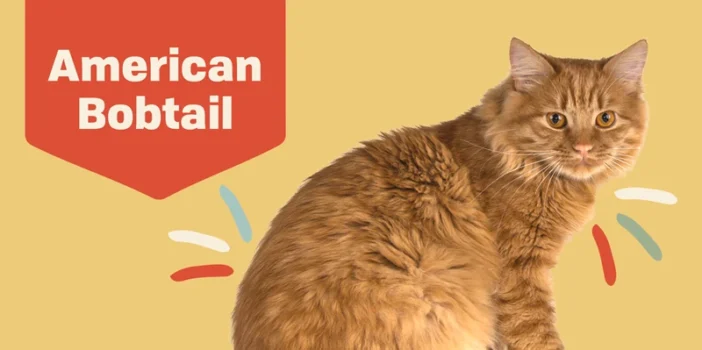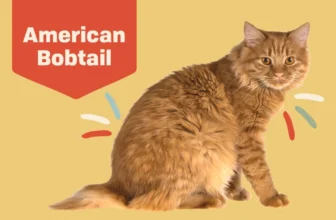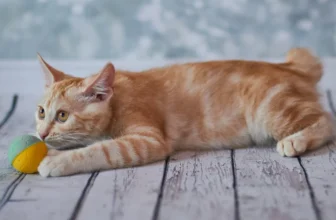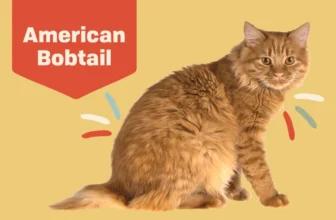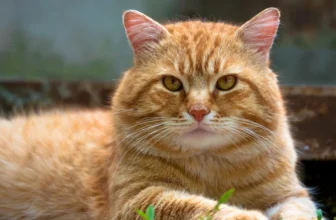Have you ever tried to decipher your American Bobtail’s emotions and struggled to understand what they’re trying to tell you? Do you wish to have a stronger bond with your feline companion? The solution might be right in front of you – by learning the importance of facial expressions in communicating with your pet. American Bobtails, like most felines, have a complex system of communication, which involves a combination of vocalizations, body language, and most importantly, facial expressions. In this comprehensive guide, we will help you unlock this intricate system and learn how to interpret your cat’s feelings just by looking at their face. So, let’s dive into the fascinating world of American Bobtail facial expressions!
The Basics of American Bobtail Facial Expressions
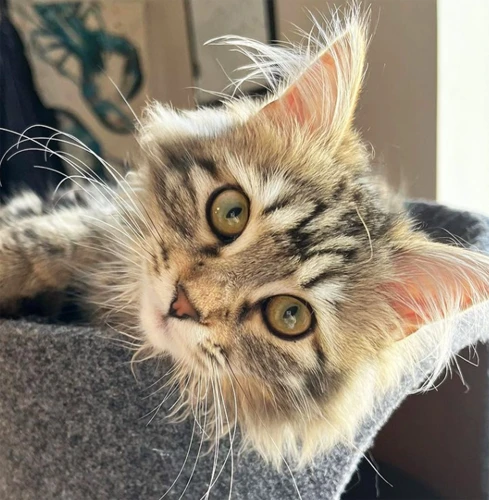
As cat owners, it’s important to understand our furry friend’s non-verbal cues. Facial expressions are a vital part of communication for American Bobtails, one of the most affectionate cat breeds. Reading your cat’s facial expressions can help you better understand their mood and needs. From their eyes to their ears and mouth movements, every facial feature can be a tell-tale sign of your cat’s current state. Understanding these features is essential for effective communication with your feline companion. By observing and learning their facial expressions and body language, cat owners can build a stronger bond while ensuring their cat is happy and healthy.
Understanding the Eyes
Cats use their eyes to express a range of emotions, including happiness, fear, relaxation, and aggression. American Bobtails are no exception, and understanding their eyes can help you better communicate with your pet. When your American Bobtail feels happy, you might notice their eyes appear relaxed and half-closed, with pupils that are not dilated. Conversely, when they feel anxious or afraid, their eyes will widen, and the pupils will dilate to let in more light. Observing the size of the pupils can help you quickly identify if your cat is comfortable or stressed.
Another important factor in understanding an American Bobtail’s eyes is the direction they are looking. If your cat maintains direct eye contact with you, it could mean they are feeling curious or playful. However, if their gaze is averted or they blink frequently, it could indicate they are uneasy or scared. Knowing whether your cat is making direct eye contact or avoiding it can help you decipher their emotions and respond appropriately.
It’s important to note that not all cats have the same facial features, and the shapes and colors of their eyes can vary. For more information about American Bobtail facial features and how to identify them, check out our guide. Whether your cat has round, almond-shaped, or even crossed eyes, their expressions will still convey valuable information about their emotions. By learning to identify and interpret these expressions, you can become a more skilled communicator and caretaker for your beloved American Bobtail.
Reading the Ears
Our feline friends are well-known for their expressive ears. Understanding the meaning behind your American Bobtail’s ear movements can greatly improve your communication with them. Here are some of the basics you should know:
| Ears | Meaning |
|---|---|
| Forward, slightly tilted | Your American Bobtail is alert and interested in something. They might be curious or trying to learn more about their environment. |
| Backward, flattened against the head | Your American Bobtail is scared, anxious, or upset. They might be feeling threatened or experiencing discomfort. |
| Relaxed, upright | Your American Bobtail is comfortable and content. They are feeling calm and safe. |
| Twitching, rotating | Your American Bobtail might be feeling playful or have detected something they want to hunt. If the twitching becomes more intense, they may be annoyed or agitated. |
| One ear forward, one ear back | Your American Bobtail is feeling unsure or conflicted. They might be curious about something but also anxious or hesitant. |
| Flat and rotated outward | Your American Bobtail is angry, aggressive, or feeling threatened. They may be poised for attack or protecting themselves or something they care about. |
Knowing how to read your American Bobtail’s ear movements can help you understand their emotions and respond appropriately. By paying attention to their ears, along with other facial expressions and body language, you can build a stronger bond with your furry feline. To learn more about American Bobtail facial features and personality, click here.
Decoding Mouth Movements
When it comes to decoding your American Bobtail’s facial expressions, it’s important to pay attention to their mouth as well. An open mouth with relaxed lips could indicate that your cat is feeling content and comfortable. On the other hand, a tensed jaw with tightened lips signals discomfort or displeasure.
Purring is a well-known sign of cat contentment, but did you know that your American Bobtail’s mouth movements can also give you insight into their emotions? When your cat slowly blinks while gazing at you, it’s a sign of trust and affection. Similarly, if your cat opens their mouth slightly and appears to be chewing an imaginary object while looking at you, it’s a sign that they feel comfortable and relaxed in your presence.
However, not all mouth movements indicate positive emotions. If your cat exposes their teeth, hisses, or growls, you should approach with caution as it could signify aggression or fear. Lip licking or excessive drooling can also indicate stress or anxiety. Paying attention to your American Bobtail’s mouth movements can give you vital information about their well-being, so make sure to give it your full attention.
Fun fact: American Bobtails are known for their distinct facial features, including a strong, broad muzzle and expressive eyes. This breed’s characteristic facial features have evolved over time and are closely tied to their genetics. To learn more about the evolution of American Bobtail facial features, check out our article on American Bobtail facial evolution and genetics.
American Bobtails have unique facial hair that requires regular maintenance. Check out our article on American Bobtail grooming for tips on keeping your cat’s facial hair healthy and clean.
Interpreting Body Language Alongside Facial Expressions
Interpreting Body Language Alongside Facial Expressions is essential for understanding your American Bobtail’s feelings and emotions. While facial expressions can give you a general idea of what your cat may be feeling, body language provides more detail about your cat’s mood and intentions.
Posture: Your cat’s posture can reveal a lot about their current emotional state. For example, if your cat is standing tall with their tail in the air, it usually indicates that they are feeling confident and curious. On the other hand, if their body is lower to the ground, with their ears flat and their fur puffed up, it is a sign of fear or aggression.
Tail: The position of your cat’s tail can also provide insight into their mood. A relaxed, slightly curved tail typically means your cat is feeling calm and content. If their tail is puffed up or straight in the air, it may indicate they are feeling threatened or excited.
Arched Back: If your cat’s back is arched, it means they are feeling threatened or aggressive. However, some cats may also arch their backs as a sign of affection or during playtime.
Purring: While purring may seem like a sign of contentment, it can also indicate pain or discomfort. Pay attention to your cat’s body language along with their purring to determine their true emotions.
By understanding your American Bobtail’s body language alongside their facial expressions, you can better communicate with them and provide appropriate care. For more information on American Bobtail facial features, visit /american-bobtail-facial-features/.
How Facial Expressions Reflect American Bobtail Emotions
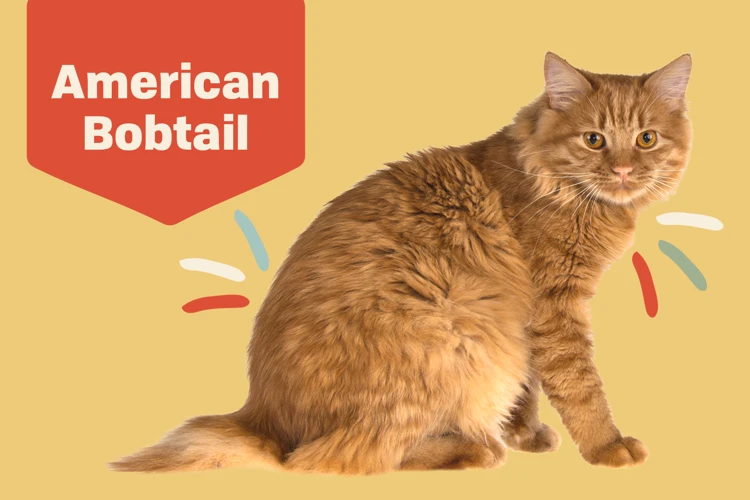
Our feline friends, the American Bobtails, are known for their expressive faces that sometimes mirror the emotions they are feeling. As cat owners, it is important to understand the various facial expressions that American Bobtails display and what they mean. By recognizing and interpreting their emotions, we can cultivate better communication and deepen our bond with them. Let’s explore the different ways in which American Bobtail facial expressions reflect their inner states.
Happiness and Relaxation
When your American Bobtail feels happy and relaxed, you will be able to see it through their facial expressions. Understanding your cat’s expressions of contentment can help you provide a more comfortable and satisfying environment for them. Here are a few expressions you might notice when your American Bobtail is happy and relaxed, along with what they mean:
| Facial Expression | Meaning |
|---|---|
| Half-closed, blinking eyes | This is a sign of trust and affection. Your cat is showing that they feel comfortable around you and are relaxed in your presence. |
| Slightly open mouth with relaxed jaw | When your American Bobtail’s mouth is slightly open and their jaw is relaxed, it is a sign of contentment. |
| Slow blinking | Slow blinking is also known as the “cat kiss”. It is a sign of affection and trust. You can return the favor by slow blinking back at your cat. |
| Relaxed ears, facing forward or slightly to the sides | This is a sign that your American Bobtail is relaxed and alert. They are aware of their surroundings but not on high alert. |
When your American Bobtail is happy and relaxed, it is essential to maintain this positive emotional state. You can do this by being aware of your own facial expressions and body language. When you interact with your cat, use a positive tone of voice and smile. Show your cat that you are relaxed and comfortable around them. This will help create a bond of trust and affection between you and your American Bobtail. Remember, a happy cat is a healthier and more content cat!
Anxiety and Fear
Just like humans, American Bobtails also experience anxiety and fear. This can be brought about by a variety of factors, such as changes in their environment, loud noises, unfamiliar people or animals, and even separation from their owners. It is important to understand how to identify these emotions in your feline companion, so that you can take appropriate measures to alleviate their stress and make them feel secure.
Facial Expressions: When your American Bobtail is anxious or afraid, their facial expressions may be tense and tight. They may squint their eyes, flatten their ears against their head, and their whiskers may be pulled back. It is also common for them to lick or bite their lips, and their pupils may become dilated.
To help you better understand the facial expressions of an anxious American Bobtail, here is a table summarizing their common facial cues:
| Facial Expression | Meaning |
|---|---|
| Squinting eyes | Anxiety, discomfort |
| Flattened ears | Fear, nervousness |
| Pulled back whiskers | Apprehension, unease |
| Licking/biting lips | Anxiety, stress |
| Dilated pupils | Fear, excitement or arousal |
Body Language: In addition to facial expressions, an anxious or fearful American Bobtail may also display certain body language, such as a hunched posture, flattened body, and a tucked tail. They may also try to hide or retreat to a safe space, such as under furniture or in a closet.
It is important to remember that anxiety and fear can be detrimental to your American Bobtail’s overall well-being. It is important to create a safe and comfortable environment for them to help alleviate any stressors that they may encounter.
If you suspect that your American Bobtail is experiencing persistent anxiety or fear, it is always best to consult with a veterinarian or a professional animal behaviorist. This will help you to better understand the root cause of your cat’s anxiety, and develop a plan to alleviate it. By being aware of your cat’s facial expressions and body language, you can help to ensure that they feel happy, healthy, and secure in their home.
Aggression and Anger
American Bobtails, like all cats, are sensitive creatures that can experience a wide range of emotions. Aggression and anger are two emotions that may be displayed through different facial expressions and body language. It is essential to understand these expressions to avoid any harm or conflict with your pet.
Aggression: Aggressive behaviors in American Bobtail cats can be expressed through various forms of body language. These signs include twitching tail, flattened ears, dilated pupils, and an arched back. Your cat may also hiss or growl when feeling aggressive. In case you notice such physical expressions, it’s best to give your cat some space.
Anger: Facial expressions, such as squinting or staring intently, indicate anger in American Bobtails. Your cat may also exhibit other signs, such as baring its teeth, flattening its ears against its head, or puffing up its fur to make itself appear larger. It is important to avoid direct eye contact with your cat when it is angry. You can try to diffuse the tension by slowly backing away while avoiding sudden movements.
Here’s a table summarizing the signs of aggression and anger in American Bobtail cats:
| Expression | Aggression | Anger |
|---|---|---|
| Tail | Twitching | Neutral |
| Ears | Flattened | Flattened Against Head |
| Pupils | Dilated | Normal |
| Back | Arched | Neutral |
| Sound | Hiss or Growl | Neutral |
| Facial Expression | Neutral or Frowning | Squinting or Staring Intently |
If your American Bobtail exhibits any of these signs, it’s essential to give it space and avoid provoking it. Aggression and anger are signs that your cat is under stress or feels threatened in some way. As a responsible pet owner, your role is to understand your cat’s behavior using reaction, body language, and facial expressions so you can help it feel safe and secure.
Sadness and Grief
When your American Bobtail is feeling sad or grieving, their facial expressions can tell you a lot about their emotional state. Some signs that your cat is experiencing sadness or grief include:
- Heavy-lidded, droopy eyes that appear sad
- Ear position can be lowered or droopy
- The mouth may be slightly open or downturned, with the corners of the mouth turned down
- The body may be hunched over, as if in sorrow
- Your American Bobtail may withdraw socially, and their whole demeanor may appear forlorn
It’s important to be sensitive to your American Bobtail’s emotional state when they are experiencing sadness or grief. You may want to offer them extra comfort and affection during this time, but it’s important to let them come to you on their own terms. Not all cats appreciate being picked up or held when they are feeling down.
If you suspect that your American Bobtail is experiencing prolonged sadness or grief, it may be a good idea to consult a veterinarian to rule out any underlying health issues. It’s also important to note that sudden changes in behavior may be a sign of a more serious medical or behavioral problem, so it’s important to seek professional help if you are concerned.
It’s important to be patient and understanding when your American Bobtail is feeling sad or grieving. By paying attention to your cat’s facial expressions and body language, you can provide them with the support and comfort they need during a difficult time.
Curiosity and Playfulness
American Bobtails are known for their curious and playful nature. They love to explore new environments and will often engage in playful activities. Here are some of the facial expressions and body language cues that indicate curiosity and playfulness:
- Wide eyes: When an American Bobtail is curious or playful, their eyes become wide and alert. They may also blink slowly to show relaxation and happiness.
- Wagging tail: If your American Bobtail’s tail is wagging, it’s a sign that they are feeling playful and excited. They may also hold their tail upright or twitch it back and forth.
- Purring: Cats purr when they are happy and content, so if your American Bobtail is purring, they are likely feeling curious and playful.
- Jumping and climbing: American Bobtails love to play and explore their surroundings. If they are jumping or climbing on furniture or other objects, it’s a sign that they are feeling curious and playful.
It’s important to encourage your American Bobtail’s playful behavior by providing them with toys and interactive playtime. Playing with your cat will help strengthen your bond and keep them mentally stimulated. Just be sure to always observe their facial expressions and body language to ensure that they are enjoying the playtime and not feeling overwhelmed or stressed.
The Impact of Your Facial Expressions on Your American Bobtail
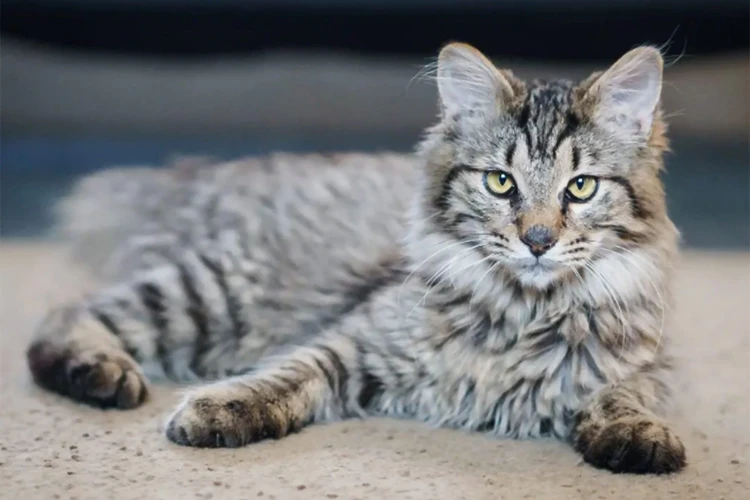
As cat owners, we understand that our furry friends have emotions just like us. And just like us, their emotions can be affected by our behavior and non-verbal communication. This is especially true when it comes to our facial expressions. It may not seem like a big deal, but the way we present ourselves to our American Bobtail can have a significant impact on their well-being and our relationship with them. Let’s delve deeper into how our facial expressions can affect our American Bobtail and what we can do to foster a positive and comfortable environment for them.
Building Trust and Comfort
Strong bonds and trust between an American Bobtail and its owner are key to a happy and fulfilling relationship. Building trust and comfort is a gradual process that requires patience, consistency, and attentiveness. Here are some tips to help you build a stronger bond with your furry friend:
- Show affection: One of the best ways to build trust is by showing your cat affection. Scratch their itchy spots, give them gentle pets, and offer them treats as rewards for good behavior. This will help your cat associate you with happy and positive experiences.
- Respect their boundaries: It’s important to respect your cat’s boundaries while showing affection. Avoid picking them up or holding them too tightly if they are not comfortable with it. This will help them feel safe and secure in their own space.
- Create a safe environment: Providing your cat with a safe and comfortable environment is crucial for building trust. Make sure there are plenty of hiding spots, toys to play with, and comfortable resting places. This will help your cat feel secure and relaxed in their surroundings.
- Be consistent: Consistency is key when it comes to building trust with your cat. Try to stick to a regular routine for feeding, playtime, and sleep. This will help your cat feel more at ease and predict their environment.
- Use positive reinforcement: Use positive reinforcement techniques to reinforce good behavior with your cat. This includes offering treats, praise, and affection when your cat does something desirable. This will help your cat associate good behavior with positive experiences.
- Be patient: Finally, building trust with your cat takes time and patience. Don’t rush the process or expect immediate results. Allow your cat to get to know you on their own terms and in their own time.
By following these tips, you can help build a stronger bond with your American Bobtail and establish a foundation of trust and comfort that will last for years to come.
Avoiding Stress and Anxiety
As a responsible American Bobtail owner, it is your primary duty to ensure that your furry friend remains happy and free of stress and anxiety. The facial expressions of your American Bobtail can be a significant indicator of their emotional state. Understanding and avoiding factors that lead to stress and anxiety is essential for your American Bobtail’s overall wellbeing. Here are some things you can do to avoid stress and anxiety in your American Bobtail:
- Provide a Safe Environment: Cats can be very sensitive to their environment, so make sure that their surroundings are safe and free of potential stressors. Your American Bobtail should have designated spots they can retreat to when they feel uneasy or overwhelmed, such as a cozy bed or a quiet corner of the room.
- Establish a Routine: American Bobtails thrive on consistency, so establishing a daily routine can help provide your cat with a sense of stability and predictability, which can reduce stress levels. Feed your American Bobtail at the same time each day, and maintain a consistent playtime schedule.
- Keep a Clean Environment: American Bobtails are naturally clean creatures, and a dirty and cluttered environment can cause anxiety and stress. Ensure that their litter box is clean, and their food and water bowls are washed regularly.
- Don’t Yell or Hit: Yelling or hitting your American Bobtail can cause severe stress and anxiety. Instead, use positive reinforcement and reward your American Bobtail for good behavior.
- Avoid Overstimulation: American Bobtails have a limit to how much stimulation they can tolerate, and too much can lead to stress and anxiety. Avoid playing with your American Bobtail for extended periods or exposing them to noisy or crowded environments.
- Provide Adequate Exercise: Regular exercise is a vital component of maintaining your American Bobtail’s overall health and wellbeing. Providing opportunities for play and exercise can keep your furry friend content and reduce stress levels.
By understanding and avoiding stress factors and using positive reinforcement techniques, you can create an environment that enables your American Bobtail to be happy and stress-free. It is vital to remember that each American Bobtail is unique in their behavior and personality, and some may require more specialized attention than others. If you are unsure about how to best cater to your American Bobtail’s needs, consult a veterinarian or an animal behaviorist.
Setting Boundaries and Reinforcing Rules
When it comes to setting boundaries and reinforcing rules with your American Bobtail, your facial expressions play a crucial role. Feline behavior specialists recommend using a combination of verbal cues and nonverbal signals to ensure effective communication.
One important technique is to use a strong and assertive facial expression when your cat is misbehaving or breaking a rule. This can include a furrowed brow or narrowed eyes, which communicates disapproval and helps your cat understand that their actions are unacceptable. You may also need to use a stern tone of voice and body language to reinforce the message.
It’s also important to reward positive behavior with positive facial expressions. When your American Bobtail follows the rules or meets your expectations, show them affection and use positive body language such as stroking their head or chin. This positive reinforcement helps strengthen your bond and encourages your cat to continue behaving in the desired manner.
Additionally, consistency is key in setting boundaries and reinforcing rules. Your American Bobtail will be more likely to understand and follow the rules if you are consistent in your commands and expectations. Use the same facial expressions and verbal cues each time to avoid confusion and misinterpretation.
Setting boundaries and reinforcing rules through facial expressions is an effective way to establish authority and build a strong bond with your American Bobtail. Make sure to use a combination of positive and assertive expressions and remain consistent with your communication to ensure your cat understands your expectations.
Tips for Effectively Communicating with Your American Bobtail
As loving pet owners, we are always looking for ways to strengthen our bond with our American Bobtails. One crucial aspect of building a strong relationship is effective communication. And when it comes to communicating with our feline friends, understanding their facial expressions and body language is key. In this section, we will provide you with some valuable tips on how to effectively communicate with your American Bobtail, helping you to deepen your connection with them and ensure that they feel understood and loved.
Observe Your Cat’s Facial Expressions and Body Language Actively
To effectively communicate with your American Bobtail, it’s essential to actively observe your cat’s facial expressions and body language. Cats, like humans, express themselves through a variety of physical cues, including facial expressions, ear movements, and tail positioning. By paying close attention to these nonverbal signals, you can better understand your cat’s mood and needs, and adjust your behavior accordingly.
Facial Expressions
One of the most prominent ways that American Bobtails communicate is through their facial expressions. A cat’s eyes, ears, and mouth all provide valuable information about their mood and intentions. When your cat is calm and content, their pupils will be dilated, and their eyes will be relaxed. However, when they’re feeling threatened or anxious, their pupils may constrict, and their eyes may appear wider and more alert. Similarly, an American Bobtail’s ears can convey a range of emotions, from alertness and curiosity to fear and aggression. When your cat’s ears are relaxed and facing forward, they’re likely feeling calm and happy. But if their ears are flat against their head or turned sideways, they may be feeling anxious, defensive or agitated.
Body Language
In addition to facial expressions, American Bobtails use their bodies to communicate as well. For example, when your cat is feeling relaxed and content, their tail will likely be held high and may even be twitching slightly. On the other hand, if they’re feeling threatened or defensive, their tail may be puffed up and held low. Additionally, a cat’s posture can tell you a lot about their mood. When your cat is feeling confident and secure, they’ll likely stand up tall, with their head held high. However, if they’re feeling scared or stressed, they may hunch down to the ground or try to hide.
Active Observation
Observing your American Bobtail’s facial expressions and body language actively is key to understanding their emotions and needs. Set aside some time each day to watch your cat’s behavior and see if you can identify any patterns or changes in mood. Keeping a record in a notebook or using a table like the one below can help you track your cat’s signals and identify any issues that may need addressing.
| Date | Time | Body Language | Facial Expressions | Mood |
|---|---|---|---|---|
| 3/15 | 2 pm | Tail held high, relaxed stance | Pupils dilated, eyes relaxed | Happy, content |
| 3/16 | 8 pm | Ears flattened, tail puffed up | Pupils constricted, eyes wide | Stressed, uneasy |
By observing your American Bobtail’s behavior actively, you can identify any changes in mood or behavior and adjust your approach accordingly. Whether your cat is feeling anxious, happy, or somewhere in between, taking the time to understand their nonverbal signals is essential for effective communication and building a strong bond.
Use Positive Facial Expressions to Build a Stronger Bond
Interacting with your American Bobtail through positive facial expressions can go a long way in building a stronger bond between you and your feline friend.
Here are some tips to help you use positive facial expressions effectively:
- Smile: Smiling is a universal sign of happiness and friendliness. When your American Bobtail sees you smiling, they can sense that you are in a good mood and that you are happy to see them. This can help to establish a positive association between you and your cat.
- Maintain Eye Contact: Maintaining eye contact with your American Bobtail while showing positive facial expressions such as smiling or nodding can convey a sense of empathy and understanding. This can help to establish trust and comfort between you and your cat.
- Speak in a Soothing Tone: Using a soothing tone of voice along with positive facial expressions can help to calm your American Bobtail and make them feel safe and comfortable around you.
- Provide Treats and Positive Reinforcement: Offering treats and providing positive reinforcement when your American Bobtail responds well to your positive facial expressions can help to strengthen the bond between you and your cat. This can create a positive association between good behavior and positive experiences.
Using positive facial expressions to communicate with your American Bobtail can be a fun and rewarding experience for both you and your cat. By incorporating positive expressions into your interactions, you can strengthen your bond and create a lasting connection with your furry friend.
Be Consistent with Expressions and Communication to Avoid Confusion and Stress
Consistency is key when it comes to effectively communicating with your American Bobtail through facial expressions. Your cat is intelligent and sensitive, and your consistency with your expressions will help reduce confusion and stress in your pet.
Here are some tips to help you maintain consistent expressions and communication:
- Understand your own expressions: Before you can be consistent with your expressions, you need to understand what they are. Spend some time observing yourself in the mirror and identifying the different facial expressions you use.
- Create a “vocabulary” of expressions: Just as words make up a language, different facial expressions can make up a communication “vocabulary.” Identify the different expressions that you will use to communicate with your American Bobtail.
- Practice your expressions: Just like any other skill, facial expressions can be practiced and improved. Spend time in front of the mirror practicing the expressions that you will use to communicate with your cat.
- Use your expressions consistently: Once you have identified and practiced your expressions, use them consistently with your American Bobtail. This will help your cat understand the meaning behind your expressions and reduce confusion.
- Pair your expressions with consistent actions and words: To reinforce the meaning behind your expressions, pair them with consistent actions and words. For example, if you always use a big smile and excited tone of voice when it’s time to play, your American Bobtail will learn to associate that expression with playtime.
Consistency in your facial expressions and communication will help build a strong bond with your American Bobtail and make your interactions more positive and enjoyable for both you and your cat.
Seek Professional Help If You Encounter Persistent Behavioral Issues
As much as we try to understand our American Bobtail’s facial expressions and body language, sometimes there may be persistent behavioral issues that we cannot solve on our own. In such cases, it is important to seek professional help.
Why Seek Professional Help?
Persistent behavioral issues in our American Bobtails can cause a lot of stress and anxiety for both the cat and the owner. These issues may arise due to various reasons, such as past trauma or medical conditions. A professional cat behaviorist or veterinarian can diagnose the issue and provide a treatment plan tailored to the specific needs of our American Bobtail.
Additionally, seeking professional help can prevent the issue from worsening and potentially causing harm to our American Bobtail or the people around them.
Choosing a Professional to Help
When choosing a professional to help with our American Bobtail’s behavioral issues, it is important to choose someone who is experienced and qualified in dealing with cats. Look for professionals who have credentials such as a Certified Applied Animal Behaviorist (CAAB) or a board-certified veterinary behaviorist.
Networking with other cat owners can also be helpful in finding trusted professionals who have a good reputation in the community.
What to Expect When Seeking Professional Help
When seeking professional help, we can expect the behaviorist or veterinarian to conduct a thorough assessment of our American Bobtail’s behavior and history. They may also ask about the cat’s diet, exercise routine, and environment.
Based on the assessment, the professional will create a treatment plan that may include behavior modification techniques, medication, or changes in the cat’s environment. They will also provide guidance on how to effectively communicate with our American Bobtail and prevent the issue from reoccurring in the future.
Remember to be patient and consistent with the treatment plan, as it may take some time to see improvements in our American Bobtail’s behavior.
Conclusion
When dealing with persistent behavioral issues in our American Bobtail, seeking professional help can be a lifesaver for both the cat and the owner. Remember to choose a qualified professional who is experienced in dealing with cats and be patient with the treatment plan. With the right help and guidance, we can ensure a happy and healthy life for our beloved American Bobtail.
| Seeking Professional Help | Why Seek Professional Help? |
|---|---|
| Prevents issue from worsening | Can cause stress and anxiety for cat and owner |
| Professional can diagnose and treat behavioral issue | Issue may arise due to past trauma or medical conditions |
| Prevents potential harm to cat or people |
Conclusion
As a cat owner, communicating effectively with your American Bobtail is crucial for building a strong relationship and avoiding behavioral issues. Understanding the importance of facial expressions in communicating with your American Bobtail can help you read your cat’s emotions and respond appropriately.
Through decoding your American Bobtail’s facial expressions, you can decipher their emotions and intentions. Knowing how to read their eyes, ears, mouth movements, and overall body language can help you establish trust, avoid stress and anxiety, and reinforce boundaries.
Facial expressions such as happiness, anxiety, aggression, sadness, curiosity, and playfulness can give you insight into what your American Bobtail is feeling, and respond accordingly. By using positive facial expressions and communicating consistently, you can build a stronger bond with your cat, and avoid confusion and stress.
It’s important to seek professional help if you encounter persistent behavioral issues. But, with active observation, positive communication, consistency, and a willingness to learn, you can effectively communicate with your American Bobtail and foster a happy and healthy relationship. So, take the time to observe your cat’s facial expressions and body language, express positive emotions, and seek professional help if necessary.
Frequently Asked Questions
What are some common facial expressions of American Bobtails?
Some common facial expressions of American Bobtails include relaxed eyes and mouth, perked up ears, and a twitching tail.
Why are facial expressions important in communicating with American Bobtails?
Facial expressions are important in communicating with American Bobtails because they can reveal the cat’s emotions and intentions, which can help you understand what your cat is trying to communicate.
How can I tell if my American Bobtail is happy?
If your American Bobtail is happy, their eyes will be relaxed, their ears will be pointed forward, and their mouth will be slightly open or closed. They may also purr or knead with their paws.
What are some signs of fear in American Bobtails?
Signs of fear in American Bobtails include dilated pupils, flattened ears, a tucked tail, and a crouched stance. They may also hiss, growl, or try to hide.
How do I know if my American Bobtail is aggressive?
If your American Bobtail is aggressive, their ears will be flattened, their pupils may be dilated, and their tail will be puffed up. They may also hiss, growl, or swipe with their paws.
What should I do if my American Bobtail seems sad?
If your American Bobtail seems sad, spend some extra time with them, give them some toys to play with, or take them for a walk outside if possible. You may also want to consult with a veterinarian to rule out any underlying health issues.
Can I train my American Bobtail to respond to facial expressions?
Yes, you can train your American Bobtail to respond to facial expressions by consistently using certain expressions to communicate with them, such as a smile to indicate happiness or a frown to indicate disapproval.
Why is it important to avoid stressing out my American Bobtail?
Stressing out your American Bobtail can lead to behavioral issues, health problems, and a strained relationship between you and your pet. It’s important to create a calm and comfortable environment for your cat to thrive in.
What should I do if my American Bobtail is not responding to my facial expressions?
If your American Bobtail is not responding to your facial expressions, try using different expressions or incorporating other forms of communication, such as body language or verbal cues. You may also want to consult with a professional animal behaviorist for additional guidance.
Can my American Bobtail’s facial expressions tell me if they are in pain?
Yes, your American Bobtail’s facial expressions can reveal if they are in pain. Signs of pain can include drooping or squinting eyes, a closed mouth, and a tense or hunched posture.

